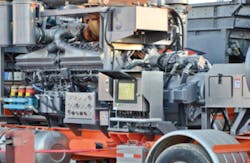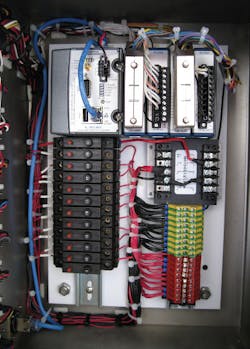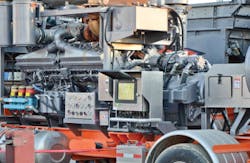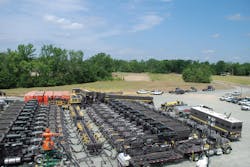The Challenge
Building an advanced monitoring system that can survive being mounted directly to an oil well servicing pump in a rugged environment while performing advanced analysis on sensor data.
Figure 1. The protoype monitoring system is built using CompactRIO. Since CompactRIO and NI Single-Board RIO have the same hardware architecture, we can switch easily between the two form factors without any major coding changes.
Application Details
The oil well monitoring system under consideration here is designed to monitor the performance of vital pump components during operation. Developed by LIME Instruments, a provider of controls and instrumentation to the energy industry, the product is focused on monitoring high-pressure fracturing pumps in well-stimulation applications. Each fracturing unit has a high horsepower diesel engine and transmission mated to a triplex or quintaplex pump. Both the engine and the transmission come equipped with an electronic interface that monitors critical functions and provides diagnostic information as the unit is running. The engine and transmission output the data they monitor via an SAE J1939 communication protocol.
Currently, pumps in this industry do not contain more than a couple of discrete sensors that monitor their critical operating parameters. Typically, discharge pressure, RPM, lube oil pressure, and lube oil temperature are monitored. Each of these parameters is measured with an individual sensor and signal cable that goes back to the main control console.
The goal of the product is to monitor these functions, as well as several others, and transmit that data back to the main control console via the same SAE J1939 controller area network (CAN) protocol. The system needs to look for data characteristics outside the normal operating envelope and failure conditions. With this real-time information, operators can determine if they should discontinue operation or continue based on real performance indications from the pump. Ultimately, the system should reduce the number of pump failures, as well as overall pump maintenance costs.
The Solution
As a packager and integrator of controls and instrumentation technology, LIME’s goal is to package with the best off-the-shelf hardware available and to package it in such a way that it withstands the harshest environments commonly found in the oil field.
For the backbone of its pump monitoring control system, LIME enlisted the help of National Instruments (www.ni.com) and its CompactRIO and NI Single-Board RIO hardware along with NI LabVIEW software. Other hardware solutions considered were not able to provide the high-speed I/O and analysis to catch the momentary pressure spikes and vibration indications of the oil well service fracturing pumps. The field-programmable gate array (FPGA) and ability to perform fast Fourier transform (FFT) analysis on the data made the combination of CompactRIO, NI Single-Board RIO, and LabVIEW a good fit for the application.
Rugged Deployment with CompactRIO and LabVIEW
LabVIEW is faster than most other programming environments, and it has made the software development side much quicker than our past experiences in C-based programming. What most C programmers take two years to do, we can accomplish in a couple of months with LabVIEW. We can use that time savings to get to market quicker and capitalize on our competitors’ lag time.
Figure 2. The goal of our product is to monitor several operating parameters and transmit that data back to the main control console. Both the engine and the transmission come equipped with an electronic interface that monitors critical functions and provides diagnostic information as the unit is running.
We are using the LabVIEW software platform to program the real-time processor, FPGA, and I/O with the CompactRIO system and interface to control and monitor every aspect of the well servicing and stimulation equipment commonly found in our industry. We believe that the modular I/O and the rugged CompactRIO system are a good solution because they can handle the shock and vibration and wide ranging temperatures experienced while mounted to a mobile piece of equipment that is dragged up and down oil field roads around the world.
The openness of LabVIEW and National Instruments hardware make it easy to interface to a variety of sensors, software, and protocols such as the following:
- Sensors—Pressure transducers, magnetic pickup sensors, digital encoders, temperature sensors, nuclear densitometers, magnetic flowmeters, Coriolis flowmeters, etc.
- Software—Coiled-tubing fatigue, wellbore-simulation software
- Operating systems—Windows XP Embedded, Windows CE, Linux
- Industry-specific protocols—SAE J1939, J1587, J1708; Modbus; Ethernet, 802.11; PROFIBUS
Figure 3. Using the NI LabVIEW and CompactRIO architecture, each frac pump system is mounted on a tractor rig with a high-horsepower diesel engine and mated to a triplex or quintuplex pump.
Customized Deployment With NI Single-Board RIO
Because of the small form factor and the low cost of NI Single-Board RIO, we see great value in using this hardware to provide a customized solution to our customers. With both CompactRIO and NI Single-Board RIO, we are able to offer the ability to create different form factors and price points for our monitoring systems.
Fortunately, the transition from CompactRIO to NI Single-Board RIO is a very quick and seamless process because of the standard NI reconfigurable I/O (RIO) hardware architecture and LabVIEW. NI Single-Board RIO has the same hardware architecture as CompactRIO, so we are able to reuse our LabVIEW code in our NI Single-Board RIO hardware without any major coding changes.
Robert Stewart is the CEO of Lime Instruments, LLC, a Houston-based provider of electrical rig-up services for land-based oil rigs, as well as controls and instrumentation for the energy industry.





